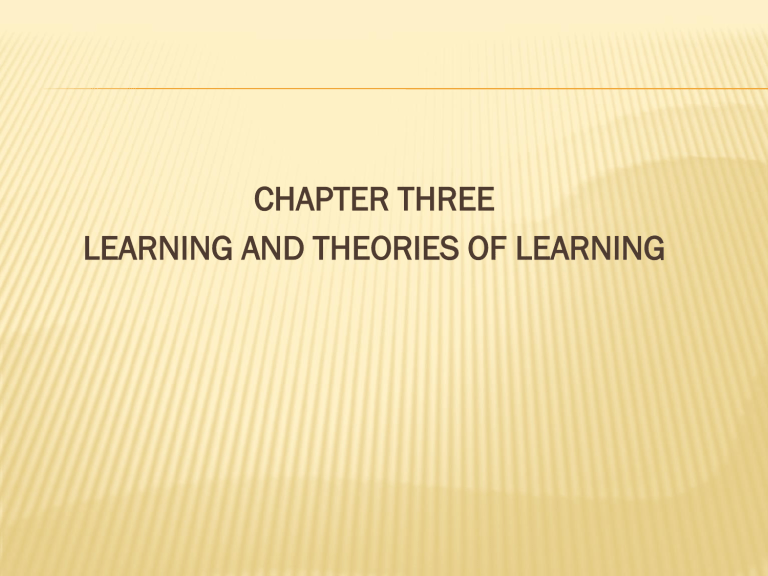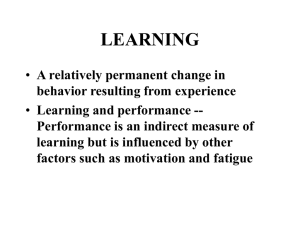
CHAPTER THREE LEARNING AND THEORIES OF LEARNING Independent reading 3.1.1. Definitions of learning 3.1.3. Characteristics of learning 3.1.3. Principles of learning 3.2. Factors Influencing Learning 3.3. Theories of Learning and their Applications 3.3.1. Behavioral Theory of Learning Stimulus response associations. 3.3.1.1. Classical conditioning theory of learning A neutral stimulus comes to bring about a response after it is paired with a stimulus that naturally brings about that response. Basics of Classical Condition Neutral stimulus Before conditioning, does not naturally bring about the response of interest. Unconditioned stimulus (UCS) A stimulus that naturally brings about a particular response without having been learned. Unconditioned response (UCR) A response that is natural and needs no training (e.g., salivation at the smell of food). Conditioned stimulus (CS) Paired with UCS to bring about a response formerly caused only by the UCS. Conditioned response (CR) A response that, after conditioning, follows a previously neutral stimulus (e.g., salivation at the ringing of a bell). Steps in Classical Conditioning Principles of Classical Conditioning Acquisition Previously neutral stimulus gets the ability to elicit response. Acquisition process Delayed Conditioning The CS is presented first and remains at least until the onset of UCS in which both the stimuli overlap. Trace Conditioning The CS is presented first and ends before then on set of UCS. It produces moderately strong conditioning. Simultaneous Conditioning CS and UCS are presented (begin) together. This produces weak conditioning Backward Conditioning The onset of UCS precedes the onset of the CS. It has least conditioning because the reinforcement comes before the CS Stimulus generalization Stimuli that are similar to the original stimulus produce the same responses. Stimulus discrimination The ability to differentiate between stimuli. Extinction The CR will diminish and eventually stop occurring Spontaneous recovery The reemergence of an extinguished conditioned response after a period of rest. Higher order conditioning Conditioned stimulus is used as unconditioned stimulus in another experiment to conditioned another conditioned stimulus Application of Classical Conditioning Aversive conditioning Unpleasant stimulation that trigger unwanted behavior Aim to induce such feelings as fear and dislike specifically in relation to stimuli Flooding Illuminate conditioned fears through fear producing stimulus is presented by it over and over again. Systematic desensitization This technique requires construction of a hierarchy of fears from least-feared to most fear Advertizing A neutral product is associated with people, objects, or situations consumers like to elicit a positive response Operant/Instrumental conditioning A voluntary response is strengthened or weakened, depending on its consequences. An emphasis on environmental consequences (Instrumental Conditioning). The organism's response operates or produces effects on the environment. Organism performs deliberately to produce a desirable outcome. The focus on the external causes of an action and the action’s consequences. Basic types of reinforcers Primary reinforcers Naturally reinforcing because they satisfy biological needs E.g., Food, water. Light, stroking of the skin, and a comfortable air temperature Secondary Reinforcers They reinforce behavior because of their prior association with primary reinforcing stimuli. E.g., Money, praise, applause, good grades, awards, and gold stars Both primary and secondary reinforcers can be positive or negative Positive reinforcement Presentation of a stimulus makes behavior more likely to occur again. Negative reinforcement Termination of an aversive stimulus makes behavior more likely to occur. Escape learning Animals learn to make a response that terminates/stops a noxious, painful or unpleasant stimulus. Avoidance Learning Learning to avoid a painful, noxious stimulus prior to exposure. Schedules of reinforcement Continuous reinforcement The response is reinforced each time it occurs. Learning is usually most rapid. intermittent (partial) Involves reinforcing only some responses, not all of them. More resistant to extinction. Fixed-ratio schedules Reinforcement occurs after a fixed number of responses. Performance sometimes drops off just after reinforcement. Variable-Ratio Schedule Reinforcement occurs after some average number of responses, but the number varies from reinforcement to reinforcement. Produces extremely high steady rates of responding. The responses are more resistant to extinction. Fixed Interval Schedule Reinforcement occurs only if a fixed amount of time has passed since the previous reinforcer. Variable Interval Schedule Reinforcement occurs only if a variable amount of time has passed since the previous reinforcer Punishment A stimulus that weakens the response or makes it less likely to recur. Primary punishers Pain and extreme heat or cold. Secondary punishers Criticism, demerits, catcalls, scolding, fines, and bad grades. The positive-negative distinction can also be applied to punishment. Positive punishment unpleasant may occur following some behavior Negative punishment Something pleasant may be removed Shaping Successive approximations of a desired response are reinforced. responses that are more and more similar to the final desired response are reinforced. Application of the theory of operant conditioning Conditioning study behavior Reinforcing student behavior through variety of incentives E.g., prize, medal, smile, praise, affectionate patting on the back or by giving higher marks. Conditioning and classroom behavior Student may acquire unpleasant experiences w/c becomes conditioned to the teacher, subject and the classroom. Managing Problem Behavior Positive contingencies are used as behavior modification therapy technique Dealing with anxieties through conditioning Using desensitization techniques to break the habits of fear. Conditioning group behavior Reinforcement makes entire group learn and complete change in behavior. Conditioning and Cognitive Processes Reinforcement is given for the progress of knowledge and in the feedback form. Shaping Complex Behavior Complex behavior exists in form of a chain of small behavior. This complex behavior can be controlled via shaping. Social Learning Theory Observational learning, which is learning by watching the behavior of another person, or model. Forms of Observational Behavior The observer may reproduce the behaviors of the model and receive direct reinforcement. The reinforcement need not be direct (vicarious reinforcement ) self-reinforcement, or controlling your reinforcers. Students value and enjoy their growing competence than external rewards. The thought processes of the learner is important. Four conditions that are necessary before an individual can successfully model the behavior of someone else: Attention The person must first pay attention to the model. Retention The observer must be able to remember the behavior that has been observed. Motor reproduction The observer has to be able to replicate the action. Motivation Learners must want to demonstrate what they have learned. Educational Implications of Social Learning Theory 1. Students often learn a great deal simply by observing other people. 2. Describing the consequences of behavior is can effectively increase the appropriate behaviors and decrease inappropriate 3. Modeling can provide a faster, more efficient means for teaching new behavior than shaping. 4. Teachers and parents must model appropriate behaviors and take care that they do not model inappropriate behaviors. 5. Teachers should expose students to a variety of other models to break down traditional stereotypes. 6. Students must believe that they are capable of accomplishing school tasks (self-efficacy) through confidence-building messages and watch others be successful. 7. Teachers should help students set realistic expectations for their academic accomplishments (not setting too high and low expectations). Cognitive Learning Theory Learning theorist (ABC) model Focuses on how people acquire information, make decisions, reason, and solve problems. Cognitive learning may take two forms: 1. Latent learning 2. Insight learning (gestalt learning or perceptual learning) Tolman and Honzic (1930) placed three groups of rats in mazes and observed their behavior each day for more than two weeks. Latent learning Learning that occurs but is not evident in behavior until later, when conditions for its appearance are favorable. Learning that is not immediately expressed. Insight Learning It is cognitive process whereby we reorganize our perception of a problem. Human beings who solve a problem insightfully usually experience a good feeling called an 'aha' experience.






